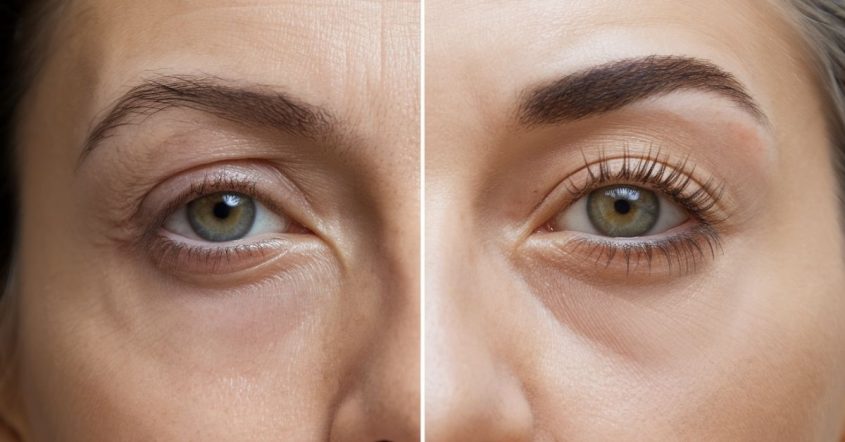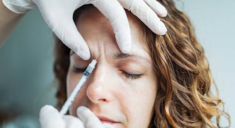Under-eye fillers are a type of cosmetic treatment used to reduce the appearance of dark circles, hollows, and fine lines under the eyes. These fillers are typically made of hyaluronic acid, which helps add volume and smooth out the skin.
Many people turn to under-eye fillers to improve their appearance and reduce tiredness or aging signs around their eyes. The treatment has become increasingly popular because it is non-invasive, meaning it doesn’t require surgery, and the results are usually visible right away.
What Are Under-Eye Fillers?
Under-eye fillers are a cosmetic treatment designed to restore volume and smooth out the skin beneath your eyes. These fillers are typically made from hyaluronic acid, a substance naturally found in your skin that helps keep it hydrated and plump.
Popular brands of under-eye fillers include Restylane, Juvederm, and Belotero. These fillers are injected into areas with dark circles, hollows, or fine lines to rejuvenate the under-eye area.
By adding volume and reducing shadows, under-eye fillers help create a fresher, smoother appearance. The results are usually immediate and can last several months, providing a more youthful look without the need for surgery.
Before and After: What to Expect from Under-Eye Fillers
Before getting under-eye fillers, it’s important to know the visible changes you can expect. Before treatment, many people struggle with dark circles, hollows, or fine lines under their eyes, which can make them appear tired or older. After the procedure, you will notice reduced hollows, as the filler restores lost volume, giving your under-eye area a fuller, more youthful appearance.
Fine lines and wrinkles under the eyes will also appear smoother, as the filler lifts and firms the skin. Additionally, dark circles may be less noticeable, as the volume adds brightness to the under-eye area, making you look more rested.
After the treatment, the results are usually visible immediately, although swelling and bruising may occur, which could temporarily affect the appearance. As the swelling goes down, the final results will start to appear within a few days, giving you smoother, rejuvenated skin.
It typically takes 1-2 weeks for the filler to settle fully, and by then, you’ll see the complete effect: a fresher, smoother, and more youthful under-eye area. Keep in mind that under-eye fillers are temporary, lasting anywhere from 6 to 12 months.
While they can significantly improve the appearance of hollows, fine lines, and dark circles, they won’t eliminate deep wrinkles or persistent puffiness. Setting realistic expectations is key, as under-eye fillers won’t provide a permanent solution, but they can offer a significant refresh to your appearance.
Who Can Benefit from Under-Eye Fillers?
Under-eye fillers can help people dealing with several common under-eye concerns. They are most effective for those with volume loss under the eyes, which often leads to a hollow or sunken appearance. This is common as we age, and fillers can restore lost volume to create a fuller, more youthful look.
Fillers are also great for addressing tear trough hollows, the deep grooves that run from the inner corner of the eye down toward the cheek. These hollows can make you look tired or older, and fillers can smooth and lift this area for a refreshed appearance. Additionally, fillers can help soften fine lines and wrinkles under the eyes, making the skin look smoother and less creased.
The ideal candidates for under-eye fillers are individuals who are looking to improve their under-eye area without undergoing surgery. This procedure works best for people who have mild to moderate under-eye concerns, such as hollows, dark circles, or fine lines. It’s a good choice for those who are generally healthy and want a non-invasive solution to refresh their appearance.
However, there are some situations where under-eye fillers may not be suitable. Severe under-eye puffiness caused by fat deposits or fluid retention might not respond well to fillers. In these cases, other treatments might be more effective. Also, individuals with certain health conditions such as allergies, active skin infections, or blood clotting disorders should avoid fillers.
It’s important to consult with a qualified specialist to determine if under-eye fillers are the right option for you based on your individual needs and health status.
The Procedure: What to Expect
Pre-Procedure Preparation: Before getting under-eye fillers, you’ll need to have a consultation with a qualified practitioner. During this meeting, the practitioner will assess your under-eye area, discuss your goals, and determine if fillers are the right choice for you.
They may also ask about your medical history and any medications you take. It’s important to avoid certain medications or supplements, such as blood thinners (e.g., aspirin or ibuprofen), for a few days before the procedure to reduce the risk of bruising. Your practitioner will provide clear instructions on how to prepare.
Step-by-Step of the Procedure:
- Numbing the Area:
The first step of the procedure involves applying a topical numbing cream to the under-eye area to minimize discomfort. Some fillers also contain a local anesthetic to further reduce pain. - Marking the Treatment Area:
The practitioner will mark the areas to be treated to ensure precise placement of the filler. - Injecting the Filler:
Using a fine needle, the practitioner will inject the filler into the marked areas under the eyes. The procedure is quick, and the practitioner will carefully monitor the amount of filler to ensure even results. - Massaging and Final Adjustments:
After the filler is injected, the practitioner may gently massage the area to ensure the filler is evenly distributed.
Duration of Treatment and Recovery:
- Treatment Duration:
The entire procedure typically takes 15 to 30 minutes, depending on the complexity of the treatment area. - Recovery Process:
After the procedure, you may experience some swelling, bruising, or mild redness around the treated area. These effects usually subside within a few days. You can return to your normal activities right after the treatment, but it’s advised to avoid strenuous exercise or applying makeup for the first 24 hours. The final results will be visible after a few days once the swelling goes down, with full results showing in about 1–2 weeks.
Under-eye filler treatments are minimally invasive, with a quick recovery time and immediate improvements. Following your practitioner’s aftercare instructions will help ensure the best results.
Benefits of Under-Eye Fillers
Under-eye fillers offer several advantages, making them a popular choice for those looking to improve the appearance of the under-eye area.
- Immediate Results with Minimal Downtime:
One of the biggest benefits of under-eye fillers is that you can see results right away. The treatment is quick, and there’s usually very little downtime. While there might be some mild swelling or bruising, these side effects typically go away within a few days, allowing you to return to your daily routine quickly. - Enhanced Appearance and Increased Self-Confidence:
Under-eye fillers can significantly improve the appearance of dark circles, hollows, and fine lines. By restoring volume and smoothing the skin, they help you look more refreshed and youthful. This improvement in appearance often leads to increased self-confidence, as you’ll feel more comfortable and satisfied with your look. - Temporary Nature Allows Adjustments if Needed:
Since under-eye fillers are not permanent, the results last for several months (usually 6 to 12 months). This temporary nature allows you to adjust the treatment if needed, either by adding more filler or making minor changes to the areas treated. If you’re not fully satisfied with the results, you can also choose to have the filler dissolved, giving you flexibility and control over the outcome.
These benefits make under-eye fillers an appealing option for those seeking a quick, non-invasive way to rejuvenate their under-eye area with minimal risk.
Potential Risks and Side Effects of Under-Eye Fillers
Under-eye fillers are generally safe, but it’s important to be aware of the potential risks and side effects. Common side effects include mild swelling, bruising, and tenderness in the treated area, which usually resolve within a few days. These temporary effects are normal and part of the body’s natural response to the injections.
However, in rare cases, more serious complications can occur. Allergic reactions to the filler material may cause redness, itching, or swelling, while filler migration can lead to uneven results or lumps. In very rare instances, if the filler is injected into a blood vessel, it can block blood flow, causing tissue damage or other complications.
Choosing a qualified and experienced professional is crucial to minimizing these risks. An expert practitioner will use proper techniques, thoroughly evaluate your medical history, and provide clear aftercare instructions to ensure a safe procedure. Researching your practitioner’s credentials and reviews beforehand is essential to ensure both your safety and the best possible results.
By understanding the potential risks and selecting the right professional, you can feel confident about the treatment and its outcomes.
Cost and Maintenance of Under-Eye Fillers
The cost of under-eye filler treatments can vary depending on factors such as the brand of filler, the expertise of the practitioner, and your location. On average, the cost ranges from $500 to $2,000 per session. This price usually includes the consultation, the filler material, and the procedure itself. It’s important to note that higher costs often reflect the quality of the filler and the experience of the professional performing the treatment.
The effects of under-eye fillers typically last between 6 to 12 months, although this can vary based on factors such as your metabolism and the specific type of filler used. Over time, the body naturally absorbs the filler, which means the results will gradually fade. To maintain the desired look, it’s recommended to schedule touch-up treatments as needed, usually once or twice a year.
Long-term maintenance involves following your practitioner’s advice and taking care of your skin. Avoid rubbing the treated area excessively, protect your skin from the sun, and stay hydrated to help prolong the effects. Regular touch-ups and a good skincare routine can ensure that your under-eye area stays smooth and refreshed over time.
Conclusion
Under-eye fillers can be a great option for reducing dark circles, hollows, and fine lines, helping you look refreshed and more youthful. They offer quick results with minimal downtime, making them a convenient choice for those looking for non-surgical cosmetic solutions. However, it’s important to consider both the benefits and potential risks before deciding on the procedure.
Take the time to thoroughly research the treatment, understand what to expect, and choose a qualified, experienced professional to perform it. A proper consultation will ensure the procedure is safe and tailored to your needs. By being informed and prepared, you can confidently make the best decision for your under-eye concerns and overall appearance.
















